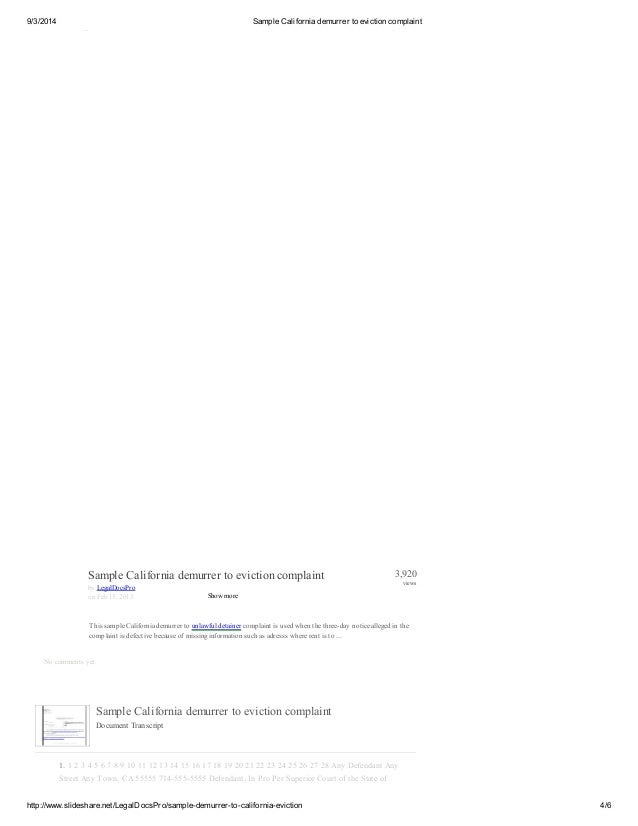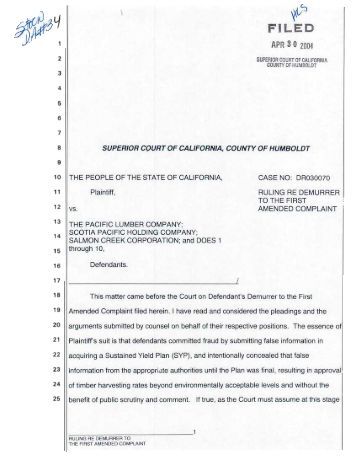Time To File Demurrer To Amended Complaint Frcp
NOTICE OF MOTION AND MOTION FOR LEAVE TO FILE SECOND AMENDED COMPLAINT. Plaintiffs,)) CIVIL ACTION FILE). Plaintiffs have now also filed an. Plaintiffs also add, for. Unless another time is specified by this rule. Within 21 days after being served with the summons and complaint; or (ii. Federal Rules of Civil Procedure for $.
Demurrer or Not to Demurrer Posted By Jenny Park Geraci Law Firm 3-Mar-2016 Demurrer or Not to Demurrer – The New California Code of Civil Procedure Section 430.41 Up to and until December 31, 2015, a defendant was able to file a demurrer to a complaint without having to meet and confer with the plaintiff. However, the demurrer landscape was recently changed when Senate Bill No. 383 was passed by the Legislature and then approved by Gov. Jerry Brown on October 1, 2015. Senate Bill No. 383 was then codified by the addition of California Code of Civil Procedure Section 430.41 (effective January 1, 2016), which mandates parties to a lawsuit meet and confer prior to filing a demurrer and imposed new limitations on demurrers. Pursuant to Code of Civil Procedure Section 430.41, before a demurrer is filed, the demurring party must meet and confer with the pleader over the objections the demurring party may have regarding the pleading.
During the meet and confer process, the parties are to determine whether an agreement can be reached that would resolve the issues raised by the demurring party. As explained below, Section 430.41 specifies the form and timing of the meet and confer process. Based on the meet and confer requirements imposed on the parties, it is clear that the Legislature and the courts are attempting to restrict the number of demurrers that are being filed in California. Meet and Confer Process Before a demurrer can be filed, the demurring party must engage in a meet and confer process with the pleader to determine if an agreement can be reached that would resolve the issues raised by the demurring party. Under Section 430.41, during the meet and confer process with the pleader, the demurring party must identify all of the specific causes of action that it believes are subject to a demurrer and identify, with legal support, the basis of the pleading deficiencies.
In exchange, the pleader must provide the demurring party with legal support for its position as to why the pleading is legally sufficient, or in the alternative, how the pleading may be amended to cure the deficiency. When to Meet and Confer In addition to imposing a meet and confer requirement, Section 430.41 imposes a deadline for when the meet and confer process should take place. Pursuant to Section 430.41(a)(2), the parties must meet and confer at least five days prior to the responsive pleading being due.
If the parties are not able to meet and confer at least five days prior to the deadline to file a responsive pleading, the demurring party shall be granted an automatic 30-day extension of time to file a responsive pleading if the demurring party files a declaration stating, under penalty of perjury, a good faith effort was made to meet and confer and the reasons why the parties could not meet and confer. The 30-day extension begins from the date the responsive pleading was due; not the date the declaration is submitted. Any additional extensions must be obtained from the court.
In the event that the parties are unable to work out their differences, the demurring party must file a declaration with its demurrer stating either (1) the means by which the demurring party met and conferred and that the parties were unable to reach an agreement, or (2) that the pleading party could not meet and confer in a good faith. Notably, the failure to meet and confer is not basis to overrule or sustain the demurrer. New Limitations on Filing Demurrers Section 430.41 also provides new restrictions on demurrers. Specifically, Section 430.41(b) provides in pertinent part that a “party demurring to a pleading that has been amended after a demurrer to an earlier version of the pleading was sustained shall not demur to any portion of the amended pleading.
Motion For Leave To File Demurrer To Evidence
On the grounds that could have been raised by demurrer to the earlier version of the pleading.” In other words, if a demurring party fails to raise an argument in the initial demurrer, the party may not raise the argument in a subsequent demurrer. Accordingly, parties should make sure they state all possible grounds to for the demurrer in the first round, or those grounds will be barred in subsequent demurrers. In addition, the parties must be prepared for the possibility of another meet and confer.
Pursuant to Section 430.41(c) when a court sustains a demurrer with leave to amend, the court may order the parties participate in a conference before an amended pleading may be filed. In the event the court holds a conference, the court cannot preclude a party from filing another demurrer and the time to file a demurrer does not start until after the conference has been concluded. Restrictions on Filing Amended Pleadings Before Section 430.41, there was no limitation on the number of times a party could amend a pleading following the filing of a demurrer. Now, in response to a demurrer and prior to the case being at issue, a pleading may not be amended more than three times with court approval. It is important to note, however, that this three-amendment restriction does not apply to amendments made pursuant to California Code of Civil Procedure section 472 where the amended pleading is filed prior to the filing of a demurrer. Should a Party Demurrer to a Pleading?
Proponents of Senate Bill 383 argued that this meet and confer process would alleviate some of the burden on the courts. Conversely, opponents to Senate Bill 383 argued that Section 430.41 would incorporate needless cost and time to the currently prolonged demurrer process. Whether you believe there will be a positive or negative impact with the addition of Section 430.41, two things are clear: (1) it will force the parties to rethink whether a demurrer is warranted, which from a defense prospective, can be useful in the end; and (2) it will force a plaintiff to try to plead the allegations more carefully because of the three amendment limitation imposed by Section 430.41(e). Many times defense counsels are too quick to file demurrers in cases where the complaint, while weak, can be amended to state viable claims. In such scenarios, defense counsel should take pause to assess whether the filing of a demurrer will simply give the plaintiff a road map as to how perfect the allegations in the complaint. The addition of Section 430.41 may very well force defense counsel to evaluate whether a demurrer is warranted or if the time, expense, and energy should be focused on filing a motion for summary judgment or summary adjudication.
The same can be true, conversely, from a plaintiff’s perspective. Often times plaintiff’s counsel will quickly draft a complaint with bare bones allegations because there were no limitations on the number of times a plaintiff could amend a complaint after a demurrer was sustained with leave to amend. With the addition of Section 430.41(e), plaintiffs will be limited on the number of times they can amend a pleading after a demurrer has been filed.

In the end, Section 430.41 may give the parties an early chance to resolve meritless lawsuits, or even cleanup the pleadings without the cost of motion exercise. This may reduce some of the burdens on California courts. However, Section 430.41 produces yet another procedural hurdle that adds to the cost of defending or prosecuting a case. The party given a lawsuit needs to immediately involve counsel to study the benefits of a complaint, while getting the automatic extension established in section 430.41, if needed.
Good or bad, Section 430.41 is here for the time being and added to see if the additional rules and restrictions imposed by the section will alleviate the burdens on the court and force parties to resolve meritless lawsuits. Time will tell if Senate Bill 383 accomplishes what it set out to do; and if it does not, then Section 430.41 may very well repealed. The statute includes a sunset clause providing that this experiment will end automatically on January 1, 2021 unless the Legislature decides otherwise. Terms and Conditions The sending of an inquiry or email to Geraci Law Firm or any of its lawyer or staff (collectively, Geraci”) does not create an attorney-client relationship. This website presents general information about Geraci and nothing contained in this site is intended as legal advice to you or anyone else and you should not consider it as such.

Please be aware that anything you send to anyone at Geraci will not be treated as or considered to be confidential, secret, privileged, or otherwise protected from disclosure unless and until we have formally agreed to represent you for a particular matter and we have successfully completed a conflicts check. Unless we have created an attorney-client relationship for a particular matter, no information that you provide in an email to Geraci will prevent Geraci from representing a different client in the same matter. Also, please be aware that until an attorney-client relationship with you exists, Geraci is entitled to use any information that you provide to us in the representation of another client. As a result, you should use good judgment and not send confidential or other sensitive information and/or documents to anyone at Geraci until you are notified that a formal attorney-client relationship has been established.